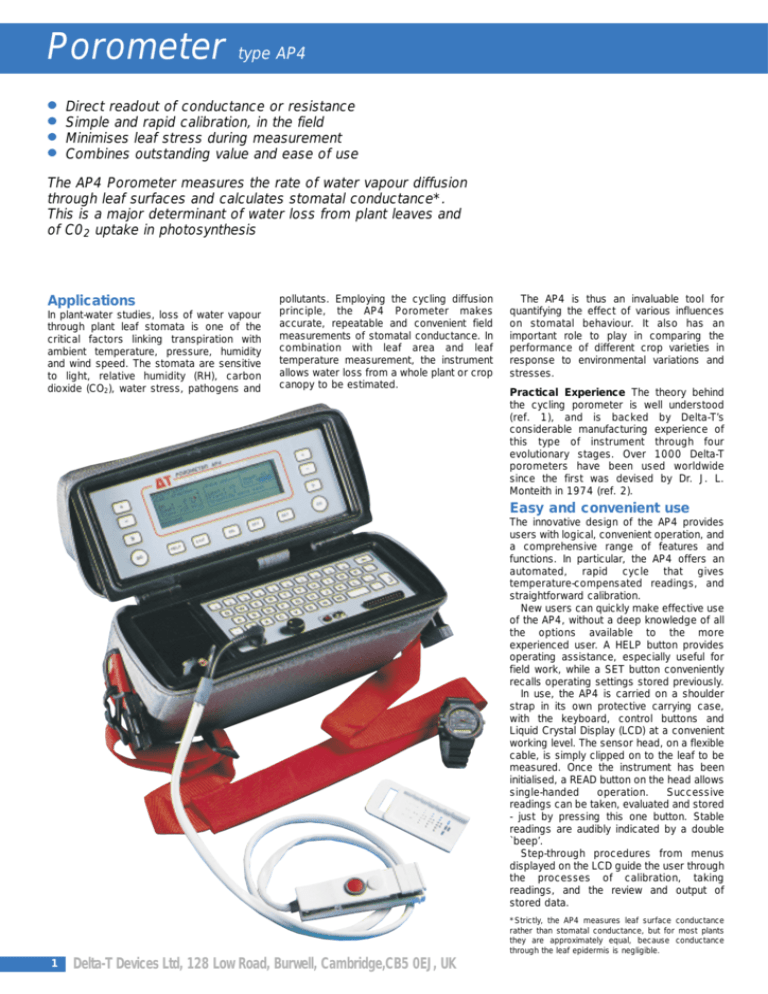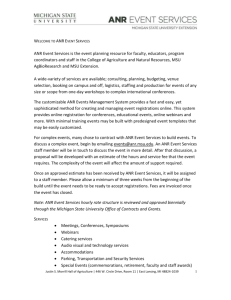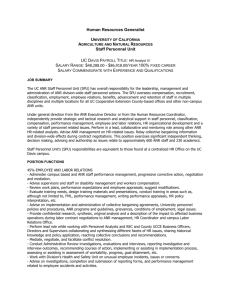Porometer type AP4
advertisement

Porometer ● ● ● ● type AP4 Direct readout of conductance or resistance Simple and rapid calibration, in the field Minimises leaf stress during measurement Combines outstanding value and ease of use The AP4 Porometer measures the rate of water vapour diffusion through leaf surfaces and calculates stomatal conductance*. This is a major determinant of water loss from plant leaves and of C02 uptake in photosynthesis Applications In plant-water studies, loss of water vapour through plant leaf stomata is one of the critical factors linking transpiration with ambient temperature, pressure, humidity and wind speed. The stomata are sensitive to light, relative humidity (RH), carbon dioxide (CO2), water stress, pathogens and pollutants. Employing the cycling diffusion principle, the AP4 Porometer makes accurate, repeatable and convenient field measurements of stomatal conductance. In combination with leaf area and leaf temperature measurement, the instrument allows water loss from a whole plant or crop canopy to be estimated. The AP4 is thus an invaluable tool for quantifying the effect of various influences on stomatal behaviour. It also has an important role to play in comparing the performance of different crop varieties in response to environmental variations and stresses. Practical Experience The theory behind the cycling porometer is well understood (ref. 1), and is backed by Delta-T’s considerable manufacturing experience of this type of instrument through four evolutionary stages. Over 1000 Delta-T porometers have been used worldwide since the first was devised by Dr. J. L. Monteith in 1974 (ref. 2). Easy and convenient use The innovative design of the AP4 provides users with logical, convenient operation, and a comprehensive range of features and functions. In particular, the AP4 offers an automated, rapid cycle that gives temperature-compensated readings, and straightforward calibration. New users can quickly make effective use of the AP4, without a deep knowledge of all the options available to the more experienced user. A HELP button provides operating assistance, especially useful for field work, while a SET button conveniently recalls operating settings stored previously. In use, the AP4 is carried on a shoulder strap in its own protective carrying case, with the keyboard, control buttons and Liquid Crystal Display (LCD) at a convenient working level. The sensor head, on a flexible cable, is simply clipped on to the leaf to be measured. Once the instrument has been initialised, a READ button on the head allows single-handed operation. Successive readings can be taken, evaluated and stored - just by pressing this one button. Stable readings are audibly indicated by a double `beep’. Step-through procedures from menus displayed on the LCD guide the user through the processes of calibration, taking readings, and the review and output of stored data. *Strictly, the AP4 measures leaf surface conductance rather than stomatal conductance, but for most plants they are approximately equal, because conductance through the leaf epidermis is negligible. 1 Delta-T Devices Ltd, 128 Low Road, Burwell, Cambridge,CB5 0EJ, UK Measurement units The AP4 lets you choose whether to work in terms of stomatal conductance or resistance, and in "velocity" or mole units. Mole units offer comparability with biochemical units in photosynthesis, for example the moles of biomass created, or the flux density of PAR quanta. They have the advantage of being independent of pressure, and only weakly dependent on temperature, whereas velocity units depend on both. The AP4 refers all readings to the ambient temperature and pressure. Data handling Onboard memory provides a storage capacity of up to 1500 readings, with a notes facility. Data is read out to a computer, printer or pocket terminal through the RS232 link. Data formats are suitable for direct entry to popular analysis software such as spreadsheets. A complete set of data comprises the reading, reading labels, time, light level, temperature and relative humidity. Up to 30 characters of notes for each reading can be added from the keypad. Direct calibration The direct calibration technique used in the AP4 gives much greater confidence in the absolute accuracy of its readings than is possible in practice with other systems. The AP4 is supplied with a moulded polypropylene calibration plate with six groups of holes; the rate of diffusion of water vapour through these holes has been carefully verified. Water vapour is provided by backing the plate with dampened paper. The sensor head is clipped onto the calibration plate, and readings are stored from each of the six standard calibration positions. Calibration is a simple process, and easily undertaken in the field. It should be carried out at the start of a measurement session, and when necessitated by a change in temperature, by moving to a new RH cycling level, or by use of the alternative cup on the sensor head. Changes in barometric pressure between a calibration and actual measurement will affect resistance readings: a change of 1kPa can cause a 1% error in measured resistance. An extreme change in the weather could have this effect, but altitude is normally a greater factor, the rate of change being 1kPa per 100 metres. The Wristwatch Barometer type PBR1, is suitable for monitoring local pressure (see Ordering Information). Compact sensor head The lightweight, compact AP4 sensor head enables reliable and quick measurements even in small or dense canopies, with minimum stress on the leaf. Made from low water absorption polypropylene, the head contains two cups (cuvettes): one slotted, the other circular, to suit different leaf shapes. A shuttered cover lets the user check leaf alignment. A silicone rubber seal presses gently onto the leaf surface, defining the sample area. The head contains fast response sensors to measure cup and leaf temperatures, allowing automatic temperature compensation to be applied (ref 3). Reflective, insulating materials reduce cup heating by bright sunlight, while a PAR photodiode sensor (Photosynthetically Active Radiation) measures light incident on the leaf. References RH sensor 1. Monteith, J. L., Campbell, G. S. & Potter, E. A., 'Theory and performance of a dynamic diffusion porometer'. Agric. For. Meteorol. 44,27-38, 1988. 2. Stiles, W., Monteith, J. L. & Bull, T. A., 'A diffusive resistance porometer for field use'. J. Appl. Ecol.7,617-638,1970 3. Campbell, G. S., 'Steady-state diffusion porometers'. Research Bulletin 809, Washington State University,20-23,1975. 4. McDermitt, D. K., 'Sources of error in the estimation of stomatal conductance and transpiration from porometer data'. HortScience,25(12),1538-1548,1990 Alternative cup Precision thermistor Silicone rubber seal Cup (cuvette) AP4 Sensor head showing exposed cup chamber. % Relative Humidity (RH) Pumping dry air +2.5% A C Set RH B D -5% δt Typical cycle of RH in the sensor head. After each reading, a pump automatically flushes the cup with dry air, lowering the RH to a set level, ready for another reading. Time AP4 Porometer in use on potato crop growing through black polythene ABCD- 8 line x 40 character LCD Function keys (right and left handed) QWERTY keypad for notes Sensor head including light sensor 2 Porometer type AP4 Dynamic diffusion and steady state porometers compared Under field conditions, the situation Porometry changes. The accuracy of the Delta-T system can be maintained by simply recalibrating in the field whenever appropriate. In the steady state system, accuracy depends on the absolute accuracy of the RH measurement: an error of more than ±18% in the diffusion reading can be caused by a ±3% RH error (refs. 3, 4). When taking measurements in the field on leaves, the possibility of contamination will usually limit confidence in the absolute RH measurement to ±4%, even with careful and frequent laboratory recalibration. Conditions within a porometer chamber can occasionally cause the stomata to close before a reading is taken. These are more likely to be present in a chamber where the leaf is stressed by the increased water loss associated with vigorously stirred steady state systems. An Applications Note comparing the accuracy and performance of porometers is available on request. Porometry is the study of gas diffusion through pores, particularly through leaf stomata. Since plant transpiration is mainly controlled by the opening and closing of stomata, the use of porometers is vital to many areas of plant research. Most field measurements are currently made by diffusion porometers, using either the dynamic or steady state measurement principle. Dynamic diffusion porometers, such as the Delta-T AP4, are characterised by simplicity, unstirred leaf chambers, and the need for frequent but easy recalibration using plates with known diffusion resistances. Steady state porometers, such as the LI-COR LI-1600, are comparatively complex, require a vigorously stirred leaf chamber, and their recalibration, while infrequent, can be difficult. Relative Strengths Accuracy: Under laboratory conditions, the two systems are comparable, though the steady state can be significantly more accurate at higher diffusion conductances when carefully calibrated. Resolution: Dynamic and steady state porometry systems offer similar resolution: approximately 0.05 s cm-1. Speed: Both systems enable a reading to be taken within about 15 seconds for a highly conductive leaf, and within about 60 seconds for a highly resistive leaf. Convenience: With the introduction of direct readout and data storage, the AP4 has overtaken existing steady state systems in convenience of use. Sampling area: Because the chamber in a dynamic system is unstirred, it is not practical to use large sampling areas in conjunction with a small RH sensor. However, users’ experience suggests that this is a very minor inconvenience, only occasionally requiring more samples to be taken. Price: Generally, dynamic porometers are less expensive because they do not require such elaborate leaf chambers or expensive gas flow meters. Ease of use, reliability, and economy without compromising on accuracy, have made dynamic diffusion porometers the choice of users in over 50 countries. Porometer type AP4 Specifications Parameter Reading range Resolution Note [1] Conductance 5.0 -1200 mmol m-2 s-1 0.1 - 10 Conductance Resistance RH Cup temp. Cup-leaf temp. PAR flux [3] Pressure RH cycle level Test Conditions Reading Range [5] >90 % 5 - 800 mmol m-2 s-1 >80 % 800 - 1200 mmol m-2 s-1 0.25 - 30.0 mm s-1 0.01 - 0.1 >90 % 0.25 - 20 mm s-1 >80 % 20 - 30 mm s-1 -1 0.2 - 40 s cm 0.01 - 0.1 >90 % 0.5 - 40 s cm-1 ±0.2 s cm-1 0.2 - 0.5 s cm-1 0 - 100% 0.1 96% -5 - +55 °C 0.1 ±0.7 °C 0 - 50 °C -5 - +5 °C 0.1 ±0.2 °C 0 - 50 °C 0 - 2500 µmol m-2 s-1 10 >85% 600 - 1200 hPa (mb), settable in steps of 5 hPa 20 - 80% RH, settable in steps of 5% [4] Measuring units Notes: [1] Resolution varies with the magnitude of the value obtained. The range shown corresponds to the reading range. In relative terms, the resolution is better than 2%, but at least the smallest amount shown. [2] Accuracy is the extent to which the measurement agrees with the true value (100% is perfect), as verified by comparing plate readings with the reference value (for a specific temperature and pressure). The stated accuracy applies over the range of the calibration plate and for optimum cup conditions, i.e. from +10 to -5 °C difference between actual cup temp. and that existing at calibration, and for +2.5 to -2.5 °C difference between leaf and cup temperatures. The accuracy of the temperature sensors is expressed as the error, the deviation possible from the true value. [3] Spectral and cosine responses are approximate only. [4] Cycling at extreme combinations of temperature, conductance and RH level may not always be possible. [5] For ambient RH 10 - 90%. Data handling -2 -1 -1 -1 Conductance: mmol m s , mm s , cm s Resistance: s cm-1, s m-1, m2 s mol-1. Calibration plate values at 20°C, 100 kPa Plate position Conductance (mmol m-2 s-1) Resistance (s cm-1) 1 2 3 4 5 6 15 25 55 132 257 513 27.3 16.5 7.4 3.1 1.6 0.8 Sensor head Cups: (a) slot, 2.5 x 17.5 mm, rounded ends; (b) circle, 6 mm diameter RH sensor: Vaisala 1518HM, thin film capacitor Temp. sensors: high precision 100K thermistors Light sensor: unfiltered GaAsP photodiode Cable length: 1.2m Size/weight: 110 x 30 x 27mm, 130g incl. cable 3 Accuracy Note [2] Reading memory: up to 1500 readings with full annotation Data interface: RS232 serial, up to 9600 baud, supplied with connector and adaptor for connection to IBM PC compatible computers Software: for PCs, saves data to a commaseparated ASCII data file (.CSV) Control unit Display: 8 lines x 40 character LCD Keys: 13 function keys, plus full QWERTY keypad Carrying case: padded with shoulder & waist straps. Size/weight: 300 x 220 x 140mm, 3kg Power supply Battery: internal rechargeable, 20 hour duration, recharge time 14 hours, life 200 to 2000 recharge cycles Charger: separate unit, 12 to 15V DC, 0.5A, 110, 220 or 240V AC mains input Ordering Information Porometer type AP4 including: built-in rechargeable battery, sensor head type PSH1, calibration plate, carrying bag, manual, quick guide, RS232 cable, data collection software, consumables kit type PCK1 (paper pads, tape, 500g silica gel, silica gel tube, 2 cup seals, cup gasket), battery charger (please specify mains 230 V AC 50Hz UK, or EURO, or 120V AC 60Hz). Optional items: Wristwatch Barometer, type PBR1, reads atmospheric pressure. AP4 consumables kit, type PCK1, complete set as included with instrument. AP4 spares kit, type PSK2, includes spare manual. Detailed list available on request. Spare AP4 sensor head, type PSH1. Spare AP4 rechargeable battery, type PSB1. Spare battery charger type AP-CHG. Spare calibration plate type AP-CP. Delta-T Devices Ltd, 128 Low Road, Burwell, Cambridge,CB5 0EJ, UK - www.delta-t.co.uk








